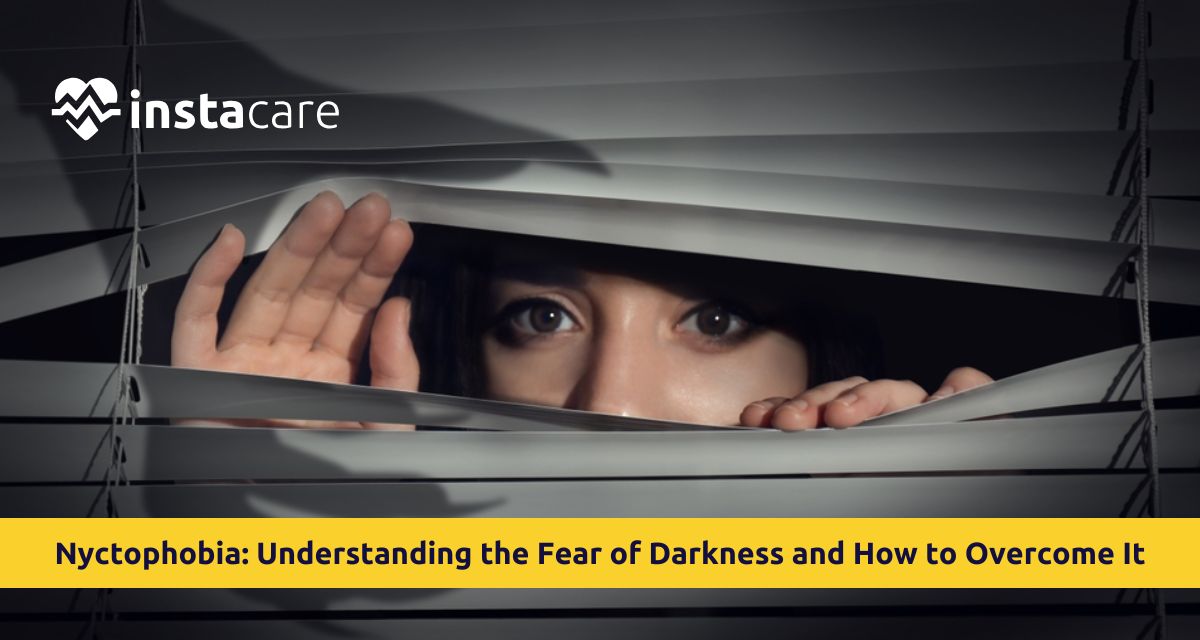What Is Nyctophobia?
Nyctophobia is excessively abnormal, irrational fear of darkness or night that goes beyond reasonable caution. Also known as achluophobia or scotophobia, the phobia triggers inappropriate anxiety reactions to dark places. In contrast to normal caution regarding dark places, nyctophobia provokes horror even when it is secure, known terrain such as an individual's own bedroom is at stake.
The emotions that lie behind nyctophobia psychology are fear of the unknown—darkness hides things out of sight, and the mind constructs the worst possible assumption to ready it for something that is not there. The distinction from ordinary anxiety is that emotions are specific and intense towards darkness.
Signs and Symptoms of Nyctophobia
Physical Symptoms
Physical symptoms of nyctophobia are increased heart rate, sweating, trembling, and
difficulty in breathing while they near dark areas. The patients may feel nauseated, dizzyly afraid, have a constricted chest, or feel as if they are choking. The body acts involuntarily even if intellectually conscious that the surrounding place is safe.
Emotional and Behavioural Symptoms
Extreme fear or horror in the process of turning off lights defines emotional reactions. Victims of Nyctophobia shun darkness at all costs, do not sleep in dark rooms, or freeze in horror when darkness cannot be avoided. Children cry and whine and hold onto parents. Adults feel ashamed of the phobia but cannot live without it.
Cognitive Symptoms
The mind is filled with violent ideas regarding threats at night. Victims fantasize about intruders, devils, or losing directions. They are unable to focus on other pending tasks until night.
Test Indicators
Although there is no universal test for the diagnosis of nyctophobia, psychological experts evaluate duration, severity, and impact of fear on life. Nyctophobia test questions determine avoidance behavior, physiological arousal, and ongoing fear despite knowledge of being safe.
Common Causes of Nyctophobia
Traumatic Experiences
Causes of nyctophobia are frequently formed by scary dark-related situations. Being alone in the dark, attacked or hurt in an accident while roaming around late at night, or having horrifying experiences under poor lighting can create recurring correlations with threat and darkness.
Evolutionary Processes
Our ancient ancestors actually faced real-night danger threats, and this filled our evolutionary psychology with fear of darkness. Although today's environment is safe, early brain modules still respond to darkness as possible danger.
Learned Behavior
Young ones who witness frightened parental responses to darkness can acquire the same responses. Overcautiousness regarding night threats or hearing frightful stories and media depicting darkness can instill fear.
Brain Chemistry
Serotonin and dopamine neurotransmitter imbalance impacts anxiety regulation. Genetic anxiety disorder susceptibility enhances the risk of nyctophobia.
Other Mental Disorders
Post-traumatic stress disorder, generalized anxiety disorder, or other phobias are usually present in association with nyctophobia. The difference between nyctophobia and general anxiety is that nyctophobia is specifically triggered by darkness, while general anxiety affects multiple aspects of life without specific triggers.
Effects of Nyctophobia on Daily Life
Sleep Disturbance
Night fear ruins sleep quality. Victims sleep lightly, breaking natural circadian rhythms and diminishing restorative sleep. Others use insomnia caused by fear of sleeping.
Social Restraints
Nyctophobia in adults puts embarrassing social restraints. Skipping night parties, camping excursions, or a night at the movies shuns social interaction and social life. Adults are ashamed to have to clarify their phobia to their boyfriends or girlfriends.
Professional Restraints
Some professions become impossible—night jobs, security jobs, or travel that includes passing through dark places. Even office jobs with darkened conference rooms make one nervous.
Family Stress
Nyctophobia shatters family routine in children. Parents lose sleep assuring terrified kids. Family activities are limited to daytimes. Nyctophobia in children might have trouble with sleepovers or school outings.
Effects on Mental Health
Ongoing fear results in ongoing depression and worry. Victims develop low self-esteem by being unusual or weak.
Coping Strategies and Treatment Options
Cognitive Behavioral Therapy (CBT)
Nyctophobia treatment is generally on the grounds of Cognitive Behavioral Therapy (CBT) in order to identify and neutralize irrational beliefs regarding darkness. Catastrophic thinking is reframed by therapists by substituting "something dreadful will happen" with realistic estimates. CBT imparts control over anxiety and gradually decreases fear reactions.
Exposure Therapy
How to overcome nyctophobia is done by the method of systematic exposure of one to darkness in a secured place. It begins with the half-dark rooms and gradually moves towards full darkness for short periods of time. Systematic desensitization involves relaxation methods with exposure, reconditioning the mind to view darkness as a security factor.
Relaxation Exercises
Coping with nyctophobia includes progressive muscle relaxation, meditation, and deep breathing. These relax physiological fear reactions, making darkness more tolerable.
Medication
Nyctophobia medication is not a primary treatment for nyctophobia but may be used in extreme cases. Anti-anxiety medications such as
benzodiazepines provide relief in the short term during therapy. Medications such as SSRIs treat underlying anxiety disorders. Medication is most effective when combined with therapy.
Mindfulness and Grounding
Skills of presence decrease catastrophizing regarding the future. Grounding activities—counting five things you see, four things you hear, three things you feel—attention to current safety instead of perceived danger.
Helping Children with Nyctophobia
Validation Without Reinforcement
Validate without reinforcing fear. Say "I see that you're scared" instead of "there's nothing to be scared of," which is denying experience. Don't look for monsters because this confirms danger potential.
Gradual Darkness Tolerance
Gradually lower light levels week by week using dimmer switches. Create bedtime routines to instill confidence and security. Use nightlights as transition aids in the process toward darkness tolerance.
Empowerment Strategies
Provide control of flashlights or glow objects. Use role-playing with courageous characters overcoming the darkness. Read children's stories about overcoming fear. Reinforce brave behavior without threat.
Professional Assistance
Receive pediatric mental health care if fear lasts beyond age six, worsens, or interferes with functioning. Phobia consolidation is avoided by early intervention using nyctophobia therapy.
Conclusion
Nyctophobia is an actual psychiatric disease deserving sympathy and successful treatment. In the child or adult, the perception of darkness fear as something to be treated rather than personal deficiency provides doors for healing. By professional therapy, self-healing mechanisms, and awareness, most people successfully remove themselves or overcome the phobia and regain nighttime confidence and doorways to broader possibilities in life.
Please book an appointment with the
best Psychologist in Lahore, Karachi, Islamabad, and all major cities of Pakistan through
InstaCare, or call our helpline at 03171777509 to find a verified doctor for your disease.

